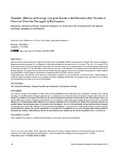Mostrar o rexistro simple do ítem
Disasters, Memory and Liturgy: Liturgical Spaces in the Reconstruction Process of Historical Churches Damaged by Earthquakes
| dc.contributor.author | Lucia, Giulia de | |
| dc.date.accessioned | 2020-04-22T11:00:06Z | |
| dc.date.available | 2020-04-22T11:00:06Z | |
| dc.date.issued | 2020 | |
| dc.identifier.citation | De LuciaContemporá, Giulia. 2020. «Desastres, Memoria Y Liturgia». Actas De Arquitectura Religiosa nea 6 (abril), 194-207. https://doi.org/10.17979/aarc.2019.6.0.6239 | es_ES |
| dc.identifier.issn | 2340-5503 | |
| dc.identifier.uri | http://hdl.handle.net/2183/25392 | |
| dc.description.abstract | [Abstract] Seismic events demonstrated the high level of structural vulnerability of Italian ecclesiastical heritage. This paper investigates liturgical reordering applied (or not applied) in the post-earthquake reconstruction of churches. The aim is to analyze if the tragic circumstance of a post-earthquake reconstruction has been taken as an opportunity to renovate the sacramental space as a whole, and above all, to evaluate in which way the memory of the disaster and mourning may have influenced the celebratory aspects. The paper focus on the several criteria that may support choices for churches reconstruction, with or without the assimilation of the liturgical modifications introduced by the Second Vatican Council. If fifty years later, the process of the liturgical modification continues to be problematic in churches with a high heritage or historical value, the issue is event more complex for those buildings affected by catastrophic event and where communities are wounded by traumatic event as an earthquake. | es_ES |
| dc.description.abstract | [Resumen] Los eventos sísmicos demostraron el alto nivel de vulnerabilidad sísmica del patrimonio eclesiástico italiano. Este artículo investiga el reordenamiento litúrgico aplicado (o no aplicado) en la reconstrucción de iglesias después del terremoto. El objetivo es analizar si la trágica circunstancia de una reconstrucción posterior al terremoto se ha aprovechado como una oportunidad para renovar el espacio sacramental en su conjunto y, sobre todo, para evaluar de qué manera la memoria del desastre y el duelo pueden haber influido en los aspecto celebrativos. El documento se centra en los diversos criterios que pueden apoyar las decisiones lpara la reconstrucción de iglesias, con o sin la asimilación de las modificaciones litúrgicas introducidas por el Concilio Vaticano II. Si cincuenta años después, el proceso de modificación litúrgica continúa siendo problemático en iglesias con un alto patrimonio o valor histórico, el problema es aún más complejo para aquellos edificios afectados por eventos catastróficos y donde las comunidades son heridas por un evento traumático como un terremoto. | es_ES |
| dc.language.iso | eng | es_ES |
| dc.publisher | Universidade da Coruña | es_ES |
| dc.relation.uri | https://doi.org/10.17979/aarc.2019.6.0.6239 | es_ES |
| dc.rights | Atribución-NoComercial 4.0 España | es_ES |
| dc.rights.uri | http://creativecommons.org/licenses/by-nc/3.0/es/ | * |
| dc.subject | Italy | es_ES |
| dc.subject | Sacred architecture | es_ES |
| dc.subject | Liturgical reordering | es_ES |
| dc.subject | Earthquake | es_ES |
| dc.subject | Ecclesiastical heritage | es_ES |
| dc.subject | Italia | es_ES |
| dc.subject | Arquitectura religiosa | es_ES |
| dc.subject | Modificaciones litúrgicas | es_ES |
| dc.subject | Terremoto | es_ES |
| dc.subject | Patrimonio eclesiástico | es_ES |
| dc.title | Disasters, Memory and Liturgy: Liturgical Spaces in the Reconstruction Process of Historical Churches Damaged by Earthquakes | es_ES |
| dc.title.alternative | Desastres, memoria y liturgia: espacios litúrgicos en el proceso de reconstrucción de iglesias históricas dañadas por terremotos | es_ES |
| dc.type | info:eu-repo/semantics/article | es_ES |
| dc.rights.access | info:eu-repo/semantics/openAccess | es_ES |
| UDC.journalTitle | Actas de Arquitectura Religiosa Contemporánea | es_ES |
| UDC.volume | 6 | es_ES |
| UDC.startPage | 194 | es_ES |
| UDC.endPage | 207 | es_ES |






